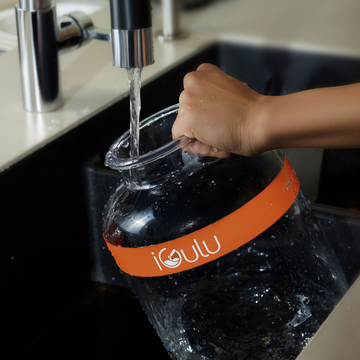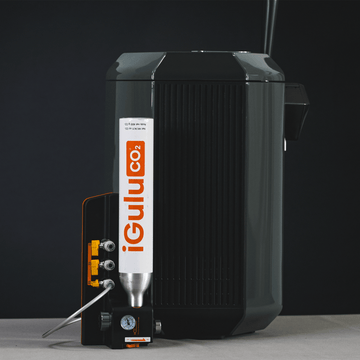Fermentation isn’t just tossing in yeast and hoping for the best. This is especially true with finicky brewers like sour beers and kombucha, which demand precision. A few degrees off in temperature or a slight pressure swing, and your masterpiece quickly turns into a mess.
But that’s all easily avoidable. Now, iGulu’s built-in Fermentech™ system does a solid job handling the basics. But there’s more you can do. Think digital probes, inline gauges, pH meters–these tools can give you exact readings and help you take the guesswork out of brewing. Let’s dive in to see how.
Built-in Monitoring vs. Upgrades
Both iGulu F1 and S1 models are equipped with Fermentech 2.0™, a built-in monitoring system that maintains a temperature range from 37.4°F to 86°F and supports pressure monitoring from 0 to 24 psi.
This setup is designed for simplicity and safety, and it works well for most brewing scenarios. It automatically adjusts pressure inside the brewer to prevent under- and over-pressurization, ensuring your brew gets properly fermented.
But while beginner-friendly, Fermentech 2.0™ is not tailored for every brewing scenario. Advanced brewers might need greater accuracy and redundancy to tackle more specialized recipes. In that case, they might need external tools for deeper insight and control. Not to replace Fermentech–but to complement it by expanding what’s possible.

Digital Temperature Probes
This is where digital temperature probes shine. These include inline thermowell or RTD (Resistance Temperature Detector) probes, which typically provide readings within ±0.5 °F accuracy compared to built-in sensors.
Installing them is pretty straightforward. There are two methods:
-
Teflon tap attachment: Wrap the tape around the probe’s fitting to insert it into the fermenter for a leak-proof seal. This method allows you to measure the actual temperature of the liquid, not just the ambient reading.
-
Foam tape application: Tape the probe around the fermenter, then cover with insulating foam to block air. This setup allows you to estimate the internal temperature without piercing or modifying the fermenter.
These tools come in handy with styles that require on-point temperature control. For instance, sour beer fermentation relies on stable conditions for bacteria to thrive, with exact ranges depending on the strains used. The same goes for kombucha, which ferments best between 75–85°F.
Probes are also useful during mash steps, where maintaining specific temperature holds is key to proper starch-to-sugar conversion.
What kind of probe to choose? We recommend waterproof food-grade digital probes or adhesive thermometer strips, the latter offering sub-1°F accuracy for minimal cost.
Inline Pressure Gauges
While iGulu’s Fermentech provides digital pressure readouts, an inline pressure gauge for the iGulu brewer, mounted between the CO₂ adapter and keg, offers a real-time, mechanical view of what's happening inside your system.
Having an external pressure gauge adds another layer of control, allowing direct monitoring of keg pressure beyond digital readouts. This is particularly handy for carbonation-sensitive beverages (like kombucha or seltzer), where precise pressure management directly impacts not just mouthfeel, but also drink safety. A slight change of just 1–2 psi can noticeably alter carbonation levels in a finished drink.
External gauges also help you catch common issues early. For example, a slight, unexplained pressure drop could mean a leaky keg seal or a slow gas leak. On the other hand, a pressure rise above expected levels may mean overactive yeast, which, if unchecked, can lead to over-carbonation or even bottle bombs.
Most homebrewers use 0–60 psi gauges. These allow you to observe subtle pressure fluctuations, which can help diagnose problems early in the fermentation or kegging process, so you can fix them before they destroy your entire batch.
pH Meter Integration
Why does pH matter when dealing with fermentation or probiotic-rich drinks? Well, not only does it impact flavor, but it also affects the microbial safety of those beverages.
There are several options for measuring pH during brewing:
-
Portable pH meters – They provide accurate, digital readings and are widely used because they can be easily calibrated before each use.
-
Inline pH probes – They can be integrated directly into the fermentation system, allowing you to continuously monitor pH in real time. This is useful for brewers who want constant data to adjust fermentation parameters on the fly.
-
Test strips – A budget-friendly choice, these are a quick alternative for checking pH, but less precise than digital meters. They are suitable for routine spot checks to ensure the fermentation is progressing within the desired acidity range.
Enhancing Consistency with Upgrades
What separates hobby brewers from serious practitioners? Consistency. Minor deviations in any parameter, be it temperature, pressure, or pH, can lead to drastic changes in flavor, carbonation, and shelf stability.
Integrating external monitoring tools into your iGulu brewing setup offers several significant advantages beyond the built-in systems' capabilities.
First, you achieve finer control over each fermentation stage. With precise temperature probes, pressure gauges, and pH meters, you can closely track those critical variables in real time and make necessary adjustments. This high level of control is particularly important when dealing with sensitive fermentations, such as sour beers or kombucha, where even slight fluctuations can significantly impact the final result.
Second, adding these tools introduces redundancy to your system. That way, you’re not relying solely on built-in sensors, and you’re taking out stuff like sensor drift, calibration errors, or hardware failure from the equation. External probes act as backups here, providing a second data point to confirm conditions and alert you if something is off.
Third, external monitoring greatly enhances repeatability. When you can precisely measure conditions from batch to batch, you can then also replicate them.
These upgrades are by no means mandatory for every brewer. But, they can be extremely useful if you want to get your brewing to the next level, no matter whether you’re making it for personal satisfaction or commercial success.
Setup Guides
Setting up your iGulu temperature probe setup and other external monitoring tools is by no means rocket science. With that being said, there are a few steps to follow to ensure accurate readings and reduce contamination risks.
First, proper probe placement is key. You should insert the tip directly into the fermented liquid rather than the headspace, as air pockets can cause false temperature measurements. Secure the probe with foam tape or a thermowell adapter. For external probes, position them between the fermenter wall and insulation–this will allow you to capture the surrounding environment’s conditions accurately.
When installing inline pressure gauges, use sanitary quick-disconnects or brass T-fittings to ensure a leak-free connection. After installation, make sure to test for leaks. You can do that by spraying soapy water on connections and watching for bubbles indicating escaping gas.
For pH testing, draw a small, sanitized sample mid-fermentation using a pipette or spoon. That way, you can track acidity changes while the microbes metabolize sugars and produce acids. Do a final pH check before cooling or bottling to confirm the desired flavor profile and safe acidity level.
Official vs Optional Upgrades
Official upgrades are accessories made by iGulu, and as such, they are designed to boost your system’s performance.
Optional upgrades are extra tools you can add yourself to get more control or features. For instance, an external pressure gauge lets you monitor pressure in real time, while a digital temperature probe provides highly accurate readings (perfect for sour beers or kombucha) and can be positioned either outside the fermenter or directly in the brew. Lastly, a handheld pH meter helps track acidity during fermentation, which is important for sour and probiotic brews.
Official upgrades cover the basics with guaranteed fit, while optional upgrades let you customize and fine-tune your brewing experience. In short, they are best when combined, giving you complete control of what’s happening inside your brew.
|
Upgrade |
Type |
Purpose |
Compatibility |
|
iGulu CO₂ Cylinder Adapter |
Official |
Enables automatic, consistent carbonation of beer and sparkling drinks |
Works seamlessly with S1/F1 via TR21×4 cylinders |
|
iGulu Accessory Kit |
Official |
Provides replacement keg lids, gaskets, and tubing for optimal sealing and sanitation |
Designed for S1 and covered under support |
|
External Pressure Gauge |
Optional (DIY) |
Adds a visual PSI display for peace of mind |
Can tap into the CO₂ line—no warranty impact if done properly |
|
Digital Temperature Probe |
Optional (DIY) |
Offers ±1 °F accuracy for sensitive brews |
Clamp-on or inline, ideal for sour/kombucha cycles |
|
Handheld pH Meter |
Optional (DIY) |
Monitors acidity in sour beers and kombucha |
Recommended for specialized brews, but not sold by iGulu |
Take Your Brew to the Next Level
If you're the kind of brewer who enjoys trickier recipes that require more precision, such as sour beers, dry-hopped ales, or kombucha, adding external tools to your iGulu can make a world of difference.
Digital temperature probes, inline pressure gauges, and pH meters–these tools help you catch problems early and fine-tune your process, resulting in batches that are right on target.
Check out our accessory store to find gear that works seamlessly with your iGulu setup. Whether experimenting with a new recipe or looking to scale up, the right tools can save you time and make brewing easy.
Have you already upgraded your setup? Show it off in the community! Share your modified iGulu rig or go-to brew–we’d love to see what you’re creating!
Frequently Asked Questions
1. Why upgrade if iGulu already controls temperature?
The built-in system works well for general brewing. But with external probes, you can achieve an even higher precision (often ±0.5°F), which is particularly important for specific brews.
2. Will external probes invalidate the warranty?
If the external sensors don’t require modifying the iGulu unit (for instance, they’re taped or inserted through a thermowell), they generally do not affect warranty coverage, but check the official policy for confirmation.
3. What’s the correct iGulu temperature probe setup and where should I place the sensor?
The probe should be fully submerged in the liquid, avoiding the headspace to prevent inaccurate readings due to temperature differentials.
4. Is it safe to install an inline pressure gauge?
Absolutely. Most gauges pose no safety risk if pressure ratings are followed. Always test for leaks after installation.
5. When and why should I measure pH during fermentation?
You should measure midway through fermentation to monitor progress and again before cooling or bottling to ensure acidity levels are within safe and desired taste ranges.
6. Can I connect all three upgrades—probe, gauge, pH—to one setup?
Absolutely. Each tool operates independently, and many experienced brewers run all three for detailed monitoring during fermentation.
7. How do I calibrate my digital thermometer or pH meter?
To calibrate a thermometer, use an ice bath (32°F) and boiling water (212°F). For pH meters, use calibration solutions (pH 4 and 7) and follow the manufacturer's procedure.
8. Does adding upgrades improve safety or taste?
Yes, more control over temperature, pressure, and pH can reduce risks like contamination, off-flavors, or bottle bombs from over-carbonation.
9. Are these upgrades compatible with both F1 and S1 models?
Yes, all recommended upgrades work with both iGulu F1 and S1 units, as they connect externally and do not require firmware integration.
10. What maintenance do these tools need?
You should wipe down probes and gauges after each use and store them dry. As for pH meters, rinse with distilled water after testing, and store with probe solution to prevent drying out.






